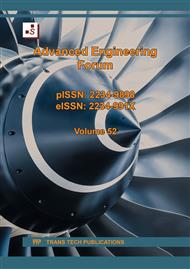[1]
J. S. Horvath, Compressible inclusion function of EPS geofoam, Geotextile and Geomembranes. 15(1997) 77-120.
DOI: 10.1016/s0266-1144(97)00008-3
Google Scholar
[2]
J. S. Horvath, The compressible inclusion functions of EPS geofoam: An overview of concepts, applications and products, Res. Rpt. No. CE/GE-98-1, Manhattan Coll. Civ. Engg. Dept., Bronx, NY. (1998a).
Google Scholar
[3]
J. S. Horvath, The compressible-inclusion functions of EPS geofoam: analysis and design methodologies', Res. Rpt. No. CE/GE-98-2, Manhattan Coll. Civ. Eng. Dept., Bronx. (1998b).
Google Scholar
[4]
J. S. Horvath, Expanded polystyrene (EPS) geofoam: an introduction to material behavior, J. Geotextiles and Geomembranes. 23 (1994) 263-280.
DOI: 10.1016/0266-1144(94)90048-5
Google Scholar
[5]
J.P. Magnan, J.F. Serratrice, Mechanical properties of expanded polystyrene for applications in road embankment, Laboratoire Central Ponts et Chaussees, paris, France, Bull Liaison LCPC, No. 164 (1989) 25–31.
Google Scholar
[6]
S. Zarnani, R. Bathurst, Numerical parametric study of geofoam seismic buffers with different constitutive models. 26 (2010) 1665-1670.
Google Scholar
[7]
O. L. Ertugrul, A. C. Trandafir, Reduction of lateral earth forces acting on rigid non-yielding retaining walls by EPS geofoam inclusions, Journal of Materials in Civil Engineering. 23 (2011) 1711-1718.
DOI: 10.1061/(asce)mt.1943-5533.0000348
Google Scholar
[8]
D. Wang, R. J. Bathurst, Numerical analysis of earthquake load mitigation on rigid retaining walls using EPS geofoam, The open civil engineering journal. 6 (2012) 21-25.
DOI: 10.2174/1874149501206010021
Google Scholar
[9]
Z. A. Athanasopoulos, K. Lamote, G. A. Athanasopoulos, Use of EPS geofoam compressible inclusions for reducing the earthquake effects on yielding earth retaining structures, Journal of Soil dynamics and earthquake engineering. 41(2012) 59-71.
DOI: 10.1016/j.soildyn.2012.05.004
Google Scholar
[10]
O.L. Ertugrul, A.C. Trandafir, Reduction of lateral earth forces on yielding flexible retaining walls by EPS geofoam inclusions, Geo Congress. (2012) 2068-2077.
DOI: 10.1061/9780784412121.212
Google Scholar
[11]
S. Zarnani, R.J. Bathurst, Numerical investigation of geofoam seismic buffers using FLAC, Geotextiles and Geomembranes. 26(2005) 371 -378.
DOI: 10.1016/j.geotexmem.2008.02.004
Google Scholar
[12]
A.C. Trandafir, O.L. Ertugrul, Earthquake response of a gravity retaining wall with geofoam inclusion, Geo-Frontiers. (2011) 3177-3185
DOI: 10.1061/41165(397)325
Google Scholar
[13]
A. Bhattacharjee, A. Muralikrishna, Behavior of gravity retaining walls subjected to seismic excitation using FLAC 3D, International Journal of Earth Sciences and Engineering. 04 (2011) 71-74.
Google Scholar
[14]
A.F. Elargi, Selected engineering properties and applications of EPS geofoam. (2006) 1-39.
Google Scholar
[15]
V.K. Gade, D. Murty, Short- and long-term behavior of EPS geofoam in reduction of lateral earth pressure on rigid retaining wall subjected to surcharge loading, Geotextile and Geomembranes. 50(4) (2022)
DOI: 10.1016/j.geotexmem.2022.05.002
Google Scholar
[16]
L.A. Raj, M. Muttharam, Effect of different compressible inclusions on lateral earth pressure reduction in rigid retaining wall, In book: Earth Retaining Structures and Stability Analysis, Proceedings of the Indian Geotechnical Conference 6 (2023)
DOI: 10.1007/978-981-19-7245-4_40
Google Scholar
[17]
P. Yu, Y. Liu, Analysis of active earth pressure behind rigid retaining wall considering curved slip surface, Geotechnical and Geological Engineering. (2023). http://dx.doi.org/
DOI: 10.1007/s10706-023-02567-6
Google Scholar
[18]
V. Singh, S. Bano, R. Kumar, V.K. Tripathi, A. Verma, Numerical study on the reduction of dynamic lateral earth pressure on retaining wall using waste tyre, IOP Conference Series Materials Science and Engineering. 1273(1): 012017 (2023)
DOI: 10.1088/1757-899X/1273/1/012017
Google Scholar
[19]
Y.E. Ibrahim, M. Nabil, Earth pressure reduction on retaining wall using EPS geofoam, Magazine of Civil Engineering. 99(7) (2020)
Google Scholar
[20]
R. Mustafa, Numerical modeling of gravity retaining wall using EPS geofoam under seismic condition, Asian J Civ Eng. (2023)
DOI: 10.1007/s42107-023-00926-5
Google Scholar
[21]
V.B. Chauhan, D. Murty, Active earth pressure on retaining wall with a relief shelf: A novel analytical method, Innovative Infrastructure Solutions. (2022)
DOI: 10.1007/s41062-021-00690-y
Google Scholar
[22]
Y.A. Elhady, E.A. Osman, Reduction of lateral earth pressure on cantilever retaining wall using geofoam (EPS) material, Journal of Advanced Engineering Trends. 42(2) (2023) 189-198
DOI: 10.21608/jaet.2022.113116.1137
Google Scholar
[23]
G. Lee, Y. Park, Earth pressure reduction effect of earth retaining walls composed of concrete piles and steel piles, Korean Society of Hazard Mitigation. 22(2) (2022) 153-162
DOI: 10.9798/KOSHAM.2022.22.2.153
Google Scholar
[24]
M.I. Khan, M. Meguid, Evaluating the role of geofoam properties in reducing lateral loads on retaining walls: A numerical study, Sustainability. 13(9) (2021). http://dx.doi.org/10.3390/ su13094754
DOI: 10.3390/su13094754
Google Scholar
[25]
S.M. Ahmed, T. Sorour, M. Saad, Reduction of earth pressure for non-yielding retaining walls using EPS Geofoam, International Journal of Scientific and Engineering Research. 11(1) (2020) 1075-1083.
Google Scholar
[26]
X. Yang, Performance of geofoam included nailed-walls in dynamic condition, Geotechnical and Geological Engineering. (2023)
DOI: 10.1007/s10706-023-02656-6
Google Scholar
[27]
V. Singh, V.B. Chauhan, Reduction of dynamic lateral earth pressure on retaining wall using waste tyre, Indian Conference on Geotechnical and Geo-environmental Engineering. (2019).
Google Scholar
[28]
R. Brinkgreve, W. Broere, PLAXIS 2D Reference Manual 2015, Plaxis bv: Delft, The Netherlands. (2015).
Google Scholar
[29]
T.N. Dave, Performance evaluation of EPS geofoam inclusion to reduce static and dynamic earth pressures on rigid retaining walls, Ph.D Thesis, IIT Bombay, India (2013).
Google Scholar


